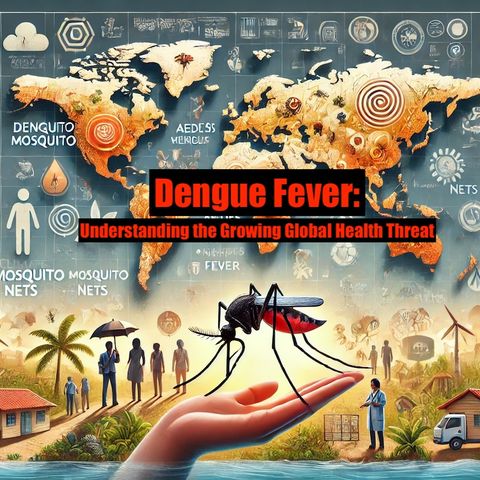Dengue Fever: Understanding the Growing Global Health Threat

Download and listen anywhere
Download your favorite episodes and enjoy them, wherever you are! Sign up or log in now to access offline listening.
Dengue Fever: Understanding the Growing Global Health Threat
This is an automatically generated transcript. Please note that complete accuracy is not guaranteed.
Description
Dengue Fever: Understanding the Growing Global Health Threat Dengue fever, a mosquito-borne viral infection, has emerged as a significant global public health concern in recent years. This potentially life-threatening disease,...
show moreIn Brazil, one of the countries most severely affected by dengue, the number of reported cases has surpassed previous records, overwhelming the healthcare system and prompting a national emergency response. The outbreak has strained medical resources, with hospitals struggling to cope with the influx of patients requiring intensive care and blood transfusions. The situation has been further complicated by the co-circulation of other arboviral diseases, such as Zika and chikungunya, which share similar symptoms and transmission patterns with dengue. The dengue outbreak in Southeast Asia has also been particularly severe, with countries like the Philippines, Indonesia, and Vietnam reporting significant increases in cases and deaths. The region's high population density, rapid urbanization, and limited resources for vector control have created ideal conditions for the spread of the disease. The outbreak has disrupted daily life, with schools and businesses forced to close in some areas to prevent further transmission. Several factors have contributed to the severity and scale of these recent dengue outbreaks. Climate change, with rising temperatures and increased rainfall, has expanded the geographic range of Aedes mosquitoes and lengthened the dengue transmission season in many regions. Rapid urbanization, often accompanied by inadequate infrastructure and poor sanitation, has created more breeding sites for mosquitoes, increasing the risk of outbreaks in densely populated areas. Furthermore, the globalization of travel and trade has facilitated the spread of dengue viruses to new regions, introducing the disease to populations with limited prior exposure and immunity. The recent outbreaks have also highlighted the challenges in preventing and controlling dengue fever. Despite decades of research and public health efforts, there is still no specific antiviral treatment for dengue, and the only licensed vaccine, Dengvaxia, has limitations and is recommended only for individuals with prior dengue infection in endemic areas. Vector control measures, such as insecticide spraying and the elimination of mosquito breeding sites, remain the mainstay of dengue prevention but have proven difficult to sustain and scale up in resource-limited settings. Prevention and Control Strategies Effective prevention and control of dengue fever require a multi-faceted approach that addresses both the mosquito vector and human behavior. The primary goal is to reduce the population of Aedes mosquitoes and minimize human-mosquito contact to interrupt the transmission cycle.
At the community level, vector control measures focus on eliminating mosquito breeding sites by removing or covering standing water sources, such as containers, tires, and gutters. Public education campaigns aim to raise awareness about the importance of personal protection measures, such as using insect repellents, wearing long-sleeved clothing, and installing window and door screens. Community participation in these efforts is crucial, as the success of vector control depends on the collective action of individuals and households. In addition to community-based interventions, large-scale vector control programs, often led by government agencies, employ strategies such as insecticide spraying, larval source management, and the release of genetically modified or Wolbachia-infected mosquitoes to suppress Aedes populations. However, the effectiveness of these methods can be limited by factors such as insecticide resistance, inadequate coverage, and the need for sustained implementation. Vaccine development has been a key focus of dengue prevention efforts, but progress has been challenging due to the complex nature of the disease and the need to protect against all four dengue serotypes. The only licensed vaccine, Dengvaxia, has been shown to reduce the risk of severe dengue in individuals with prior dengue infection but may increase the risk in those who have never been infected. As a result, the WHO recommends the vaccine only for individuals with a documented history of dengue infection in endemic areas, limiting its widespread use as a primary prevention tool. Improving dengue surveillance and outbreak response is another critical component of control efforts. Early detection of cases and rapid implementation of control measures can help contain outbreaks and prevent further spread. Strengthening laboratory capacity for dengue diagnosis, as well as enhancing data collection and analysis systems, can provide valuable information for guiding public h
Information
Copyright 2024 - Spreaker Inc. an iHeartMedia Company
